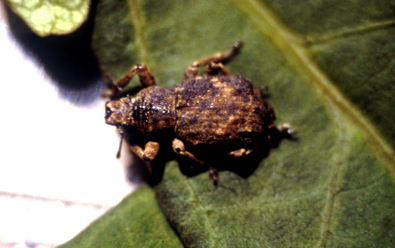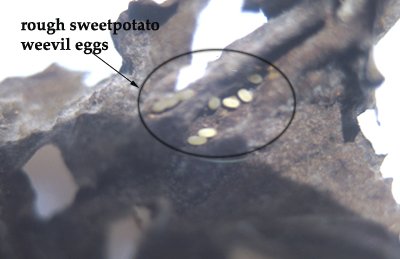|
|
Class
|
Insecta
|
|
Order
|
Coleoptera
|
|
Family
|
Curculionidae
|
Blosyrus
spp. are a production constraint in some localities in East and Southern Africa.
They are considered a constraint only in some,
relatively dry, agroecological zones.
Kenya, Tanzania, Uganda, South Africa, Zambia. In
other areas, particularly subtropical to temperate zones, the larger but related
Whitefringed
beetle may cause similar damage.
Adult weevils feed on the foliage, but the larvae cause
greater damage. While feeding under the soil surface, they gouge shallow channels
on the enlarging storage roots. These grooves reduce marketability. When
extensively damaged, the skin of the storage root has to be thickly peeled
before eating, because the flesh turns dark-greenish just under the grooves.
Egg. The eggs are pale yellow in colour.
Larva. The larvae are whitish and
c-shaped and lack legs.
Adult. The adult weevils are about
8 mm long and 4 mm wide. They are completely brownish or blackish, and the
surface of the elytra is ridged
and rough. This
makes them look like a lump of soil.
Females lay eggs in batches of 15-25
close to the edge of the sweetpotato leaves, mostly at the tip. The leaf edges
are folded around the eggs and attached such that they are not visible and are
protected. Eggs are also found underneath fallen leaves. Development is
temperature-dependent. The egg stage takes about seven days under temperatures
of 20-25oC. The larvae roll the leaves and drill themselves in the
soil, head first. They locate the storage roots and feed on the outer layers. After a larval
stage of about thirty days at 20-25oC, the pupae are formed in the soil. The pupal stage last for about twenty days. Adult weevils are found
on the ground underneath foliage during the day.
The adult weevils and eggs are easily overlooked in the
field. The presence of purple to black frass, about 7 mm in diameter, is a
sign of an abundance of rough sweetpotato weevils.
The biology of the weevil makes it a difficult insect to
control.
Biological control
The pathogenic fungus Beauveria sp. was observed
on adults in the field.
Cultural control
Measures like sufficient rotation, use of clean planting
material, sanitation and timely planting should be effective in reducing
incidence of this pest.
Ames, T., Smit, N.E.J.M., Braun, A.R., O’Sullivan, J.N., and Skoglund, L.G.
1996. Sweetpotato: Major pests diseases, and nutritional disorders.
International Potato Center (CIP). Lima, Perú. 152 p.
Bosch, S.E., 1973. The occurrence of Blosyrus spp.
weevils on sweet potato. Roodeplaat Bulletin. In Afrikaans.
Contributed
by: Nicole E.J.M. Smit |
Taxonomy
Economic
importance
Geographical
distribution
Damage
Morphology
Biology
and ecology
Detection
and inspection
Management
References

Damage
on storage roots (N. Smit).

Rough
sweetpotato weevil adult (N. Smit).

Eggs
on undersurface of a fallen, decomposing leaf (N. Smit). |

